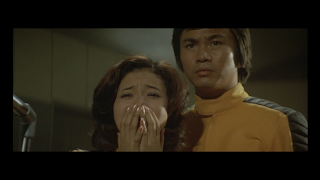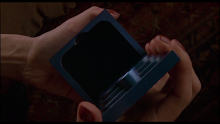Noël 1977, Star Wars est un événement au Japon. Le cinéma japonais aura son space opera, ce sera
de Jun Fukuda, réalisateur en 1973 de Godzilla vs Megalon (Gojira tai Megaro).
War in Space est si mauvais que l'on hésite à le qualifier de parodie de Star wars !
Les effets spéciaux renvoient la question de la profondeur de champ à ses débuts : les vaisseaux spatiaux flottent dans les airs, suspendus à des fils que le spectateur attentif peut voir. Les champs d'étoiles sont éteints. L'industrie japonaise du cinéma de science-fiction est en 1977 à des années lumière des studios américains.
Tour d'horizon de War in Space
1988, la Terre est dans la crainte d'une attaque d'ovnis...
qui ont détruit la station orbitale et s'approchent de la Terre.
C'est toutefois sans compter avec le vaisseau Gothen (sans commentaire).
Les petites boules volantes attaquent...
Vous remarquez les mêmes faisceaux lasers rouges que dans Star Wars !
Quelle variété de point de vue !
Finalement, l'attaque est repousée. Le vaisseau Gothen quitte la Terre pour débusquer l'ennemi sur Vénus.
L'intégration du vaisseau au matte painting est catastrophique.
Le vaisseau avance avec des fusées à combustion ! ( Il y a beaucoup de fumée dans War in Space.)
Arrivée sur Vénus...
Après exploration de la planête, les héros trouvent la base ennemie.
Les tubes verts sont les voies de circulation. Les suppositoires verts avec lumière rouge, les véhicules. (Boite Noire n'est pas en mesure d'identifier l'usage du multicolore engin au centre. Avis aux lecteurs...)
Mais le maître des lieux aime aussi le style antique...
Perplexes, les héros recherchent Yuko Asano qui joue June Takigawa.
oui, elle ! qui a été habillée par les Vénusiens d'un petit bikini de cuir ! (Yuko Asano deviendra d'ailleurs un sexe symbole). Quant à la bête à côté d'elle, ah !
Le chef suprême des ennemis en négociation avec le commandant du Gothen. La diplomatie échouera...
(Drôle de télévision, non ?)
Quoi ! Qu'est-ce ? ? ?
Ca fait peur, n'est-ce pas ?
Le cruel chef vénusien paralyse le héros !
Bien que l'emploi de costumes est une tradition dans le cinéma japonais, la référence à l'antiquité romaine est étonnante dans un film de science-fiction : peut-être, faut-il y voir le symbole d'un empire militaire expansionniste. Je développerai (un peu) plus tard.
Les héros s'échappent mais tombent sur...
le canada-dry de Chewbacca. Les cornes sont le signe de sa férocite. Le gentil wookie n'en porte pas, comme la hache d'ailleurs.
Le combat est féroce, vous pouvez imaginer...
Canada-dry Chewbacca meurt...
L'affrontement final est inévitable.
Un combat naval...dans l'atmosphère enfumée de Vénus !
Le vaisseau (galère) vénusien.
Le Gothen possède une arme redoutable : un barillet de revolver laser !
L'arme de destruction des vénusiens : un joli canon à faisceau d'énergie rose et orange.
Mais les terriens ont l'arme définitive. Le commandant pilote de missile perforant. Cependant, cette arme exige son sacrifice (puisqu'il l'a conduit vers la cible).
Le commandant a alors cette réflexion : "Cette bombe ne doit jamais être construite à nouveau. Elle ne doit jamais être utilisée. Ceci est ma prière."
War in Space est un hymne au pacifisme (?) une oeuvre évoquant le traumatisme de la bombe atomique. (On sait que ce thème hantera le cinéma japonais.)
Le vaisseau ennemi s'abîme dans un volcan.
Difficile de supporter le nécessaire sacrifice du commandant.
Les terriens quittent Vénus qui...
explose.
Fin
Boite Noire remercie Yvan Guyot pour avoir fait découvrir cette curiosité dans l'histoire de la science-fiction.






































